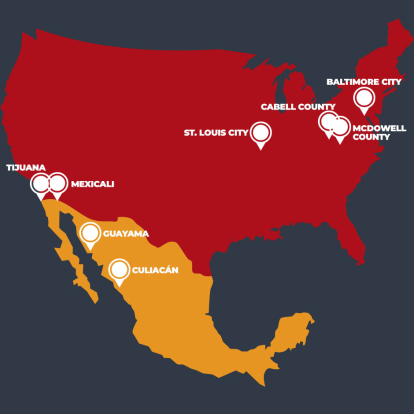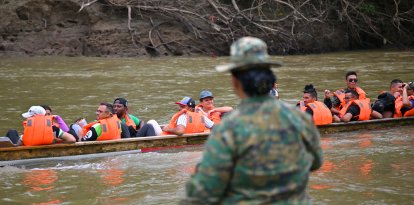From Tijuana to San Francisco, how fentanyl makes its way to America
Fentanyl use is increasing both in Mexico and the United States. Mexican cartels manufacture and sell it. They have even gone so far as to test their products on Mexican citizens.

(Christian Camacho)
"It's boring," says a minor with his face covered while stuffing fentanyl powder inside a capsule. He has to assemble 21,000 pills each week. He wears gloves, but no protective mask: "Fentanyl powder has several very toxic properties for health, unfortunately, several of my colleagues have died."
He is a 'packer.' He told the team from NMás that he does not use fentanyl, "because those of us who have been in the kitchen, we know." The 'cook' at the secret drug lab in the mountains of Mexico also refuses to use fentanyl for the same reason.
That lab is one of the facilities where production of fentanyl moved after China regulated production "after years of intense U.S. diplomacy," according to Vanda Felbab-Brown of the Brookings Institution. China, however, did not disappear from the equation: drug precursors are produced there, and they also provide the traffickers with money laundering services.
Human run labs
These secret labs aren't the only ones to blame. "There's a whole marketing strategy for the introduction of fentanyl in Tijuana," said Victor Clark, director of the Binational Center for Human Rights and professor of Latin American Studies at the University of San Diego, in statements collected by the Mexican media outlet Excelsior.
He explained that labs in Mexico began mixing fentanyl with other drugs to help build up people's resistance. They also calculated doses and observed the effects:
"We have evidence (...) where the cartels knew that there was deadly fentanyl, that the amount of fentanyl that they were sending to us was deadly because they tested it on human beings in Mexico—and they still sent it anyway," said George Papadopoulos, DEA's principal deputy administrator in the House of Representatives. Something similar was stated by Attorney General Merrick Garland when he filed charges against the Sinaloa Cartel:
He added:
Fentanyl in pharmacies
In some locations, such as Tijuana, fentanyl is sold on the street. That is the case of Tijuana, according to Clark from the Binational Center for Human Rights.
In some tourist areas, it is sold in locations that appear to be pharmacies. It is marketed on posters in English, aimed at American tourists. Researchers at the University of California, Los Angeles, analyzed products sold by 40 locals in four cities frequently visited by tourists. Most of the drugs were counterfeited, 30% of the doses that they sold as oxycodone had fentanyl.
On one occasion, a researcher noticed when asking for 'oxy' that there were blue and green pills. When he asked the two young women behind the counter, they gave him a brief explanation:
In an interview in 2022, a buyer who claimed to have "been buying oxy for years here" explained that throughout the previous year, he had noticed how the product became cheaper and more powerful, so he went from shopping "once in a while" to "like seven a day if I had the money."
"Each pharmacy and each group of small-time gangsters there is affiliated either with the Jalisco New Generation Cartel or the Sinaloa Cartel," a U.S. government official told Vice.
At the beginning of the month, the Mexican authorities announced that they had closed 20 of these 'pharmacies' in Quintana Roo, a tourist hot spot. This led the Los Angeles Department of Health to issue a travel advisory warning people to avoid travel to Mexico:
How does it make it into the United States?
Legal entry points and U.S. citizens. Those are the most common ways fentanyl makes it over the border. 90% of seizures are at legal ports of entry, according to the Brookings Institution. 85% of those convicted of trafficking were Americans.
Aaron Reichlin-Melnick, policy director of the American Immigration Council, said that "it’s well-documented trafficking patterns which have existed for decades." Reichlin-Melnick shared a graph of fentanyl seizures over the past two and a half years. Of the more than 500 incidents, smugglers were only found crossing on foot between ports of entry eight times:
Another graph shared by David Bier of the Cato Institute shows that 89% of smugglers caught with fentanyl in 2022 were U.S. citizens. Illegal immigrants accounted for 8.9%. "U.S. citizens (who are subject to less scrutiny) when crossing legally are the best smugglers," Bier said in a Cato Institute report.
"Mexican cartels intensively hire U.S. citizens (...) because U.S. citizens generate less suspicion and are often subject to less inspection scrutiny than foreign nationals," according to the Brookings Institution. The same can be said about the U.S. license plates: "Drugs, such as fentanyl, are frequently hidden in concealed vehicle compartments driven by U.S. citizens with U.S. license plates."
In addition, sources from the institute claim that smugglers use drones to help them cross by land and boats to cross by sea. Voz Media previously reported on their advanced technology.
'Sister cities'
Baltimore City and McDowell County are the U.S. capitals for fentanyl. On the other side of the border, the dubious honor goes to Tijuana and Mexicali. An InSight Crime report added Guayama and Culiacán to the list. All are cities in the northwest of Mexico.

mapa-fentanilo
The images of people lying on the ground, defenseless, or walking aimlessly that have gone viral in North American cities are also common sights in Mexico. Influencer Darren Stallcup, who has been leading a campaign to declare a state of emergency in San Francisco, recorded with his iPhone how approximately 50 people were injecting and smoking fentanyl near a federal building:
The fentanyl crisis is spreading rapidly across the United States. This is on the doorstep of the main government building in San Francisco. Why isn't this the main issue in the media? This is destroying this country.
In Tijuana, located in the Mexican state of Baja California, an X user (Twitter) shared a video of a man on the street strung out on fentanyl:
In another video from Tijuana, shared by journalist Alfredo Álvarez, a Red Cross lifeguard explains how they treat fentanyl overdoses. He said, "There are about two to three overdoses per day, more or less. The last month we have statistics for, which is April, we treated 59 overdoses." "So far this year we have 233 overdoses."
The rise of fentanyl brought an increase in crime. "While the administration of President Andrés Manuel López Obrador persists in its do-little policy, Mexican criminal groups are resorting more and more to brazen violence while enjoying high levels of impunity in Mexico," said Vanda Felbab-Brown from the Brookings Institution. She also explained that the cartels expanded their portfolio to "dominate" a variety of legal economies such as fisheries, logging and agriculture.
AMLO's government said in June that it had seized 1,727 kilos of fentanyl. In six months the government seized more than the previous year. Local media outlets reported data from the National Commission against Addictions, which revealed that consumption increased by 72% in 2022. They recognize that consumption is up but only among "a very limited number of consumers." That's despite President López Obrador's claims that Mexicans don't use fentanyl.
The 318 deaths recorded by Mexican authorities are far from those reported in the states, as shown by preliminary data from the CDC for the same year: "In 2022, provisional data indicated that more than two-thirds (68%) of the reported 107,081 drug overdose deaths in the United States involved synthetic opioids other than methadone, principally illicitly manufactured fentanyls."
Now that the drug has taken over America, it is making its way across the Atlantic. New reports indicate that consumption is on the rise in Europe.
RECOMMENDATION





















